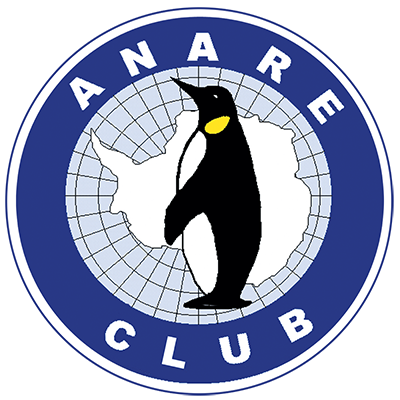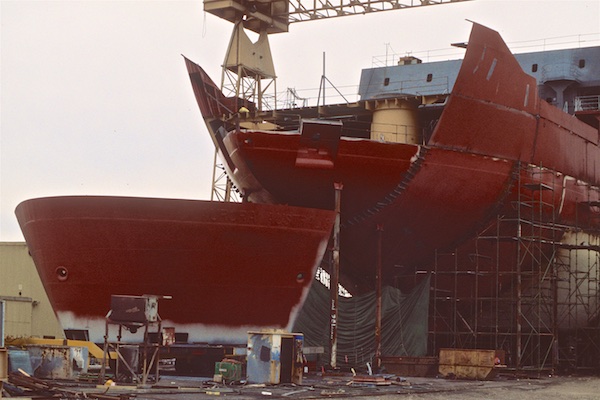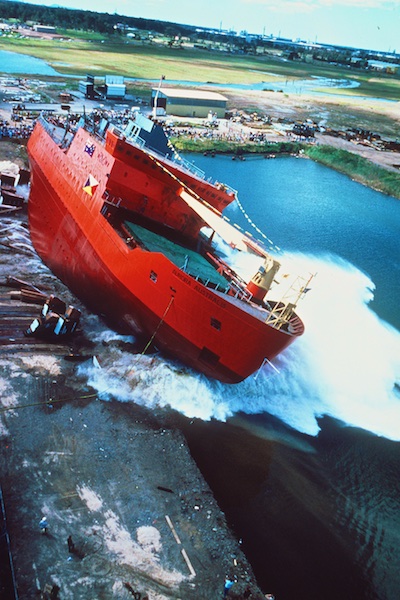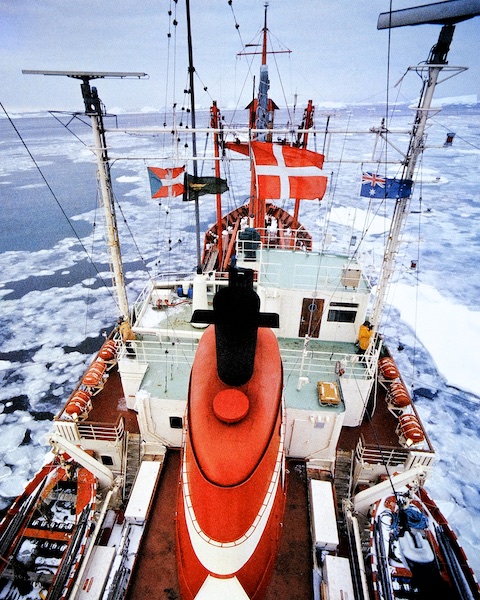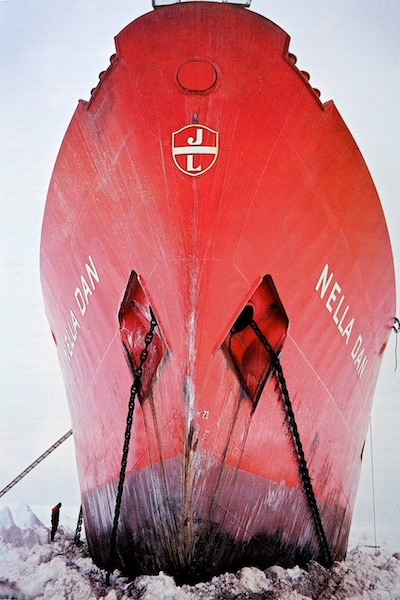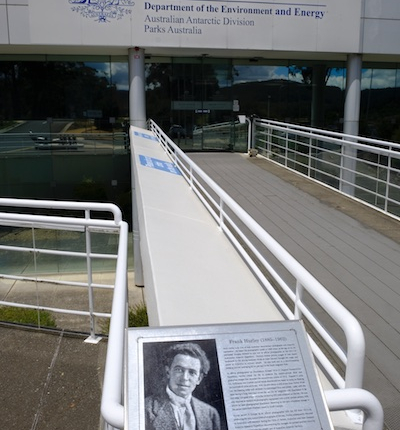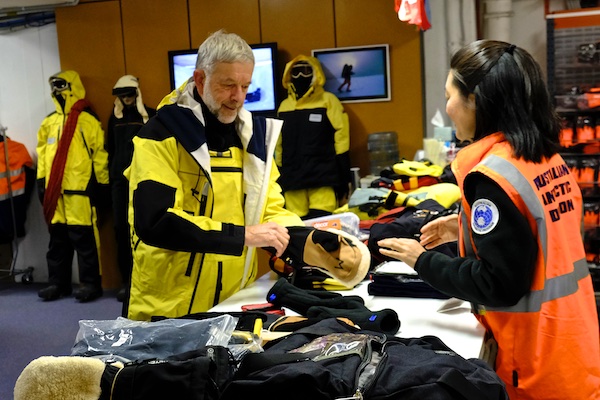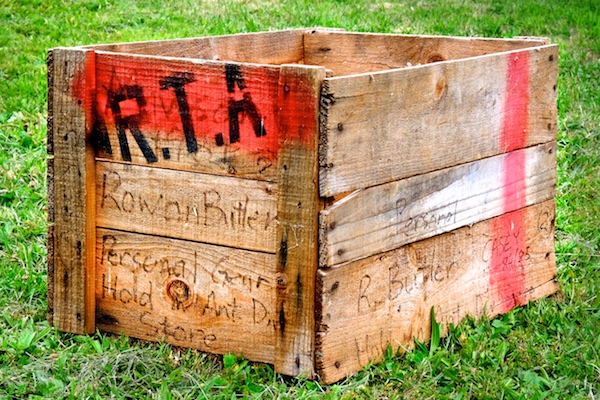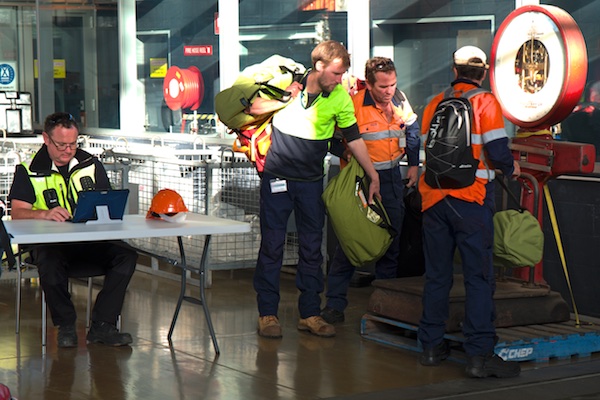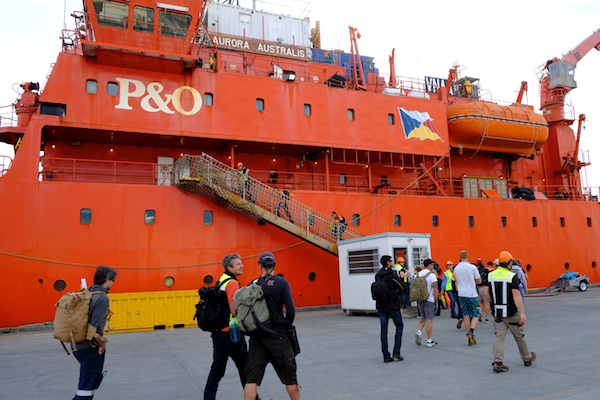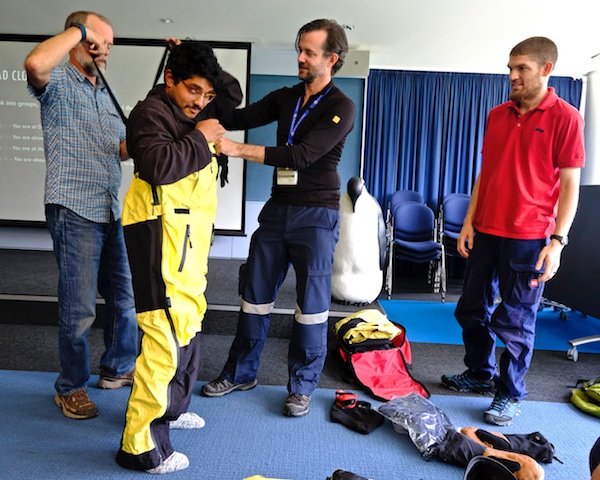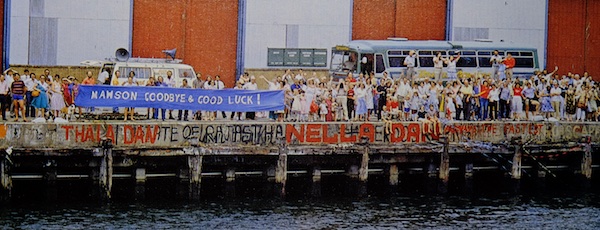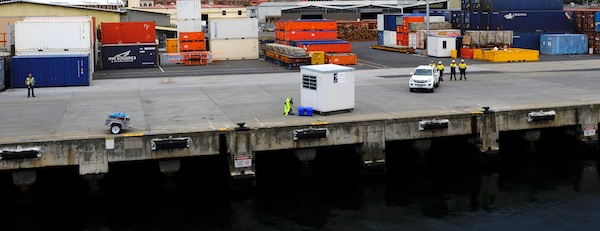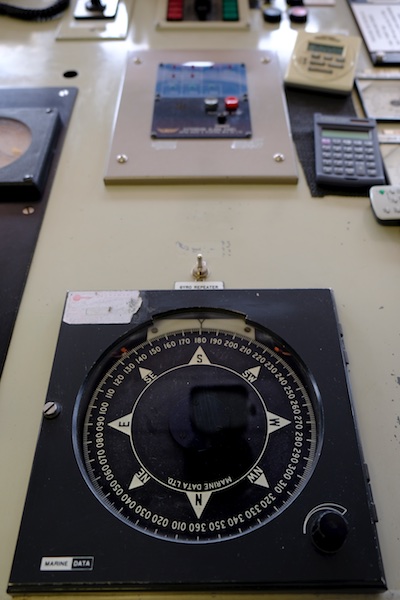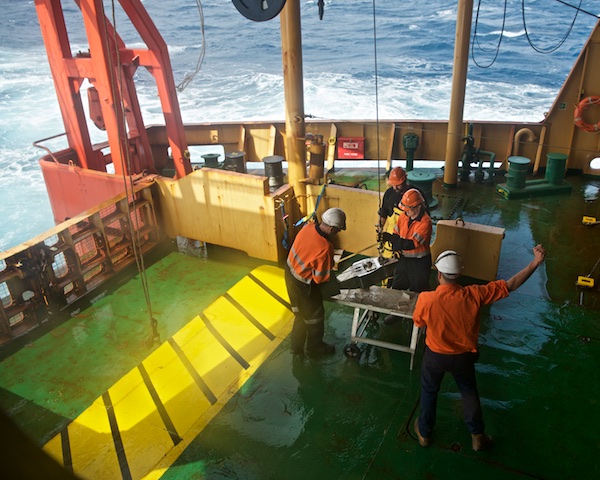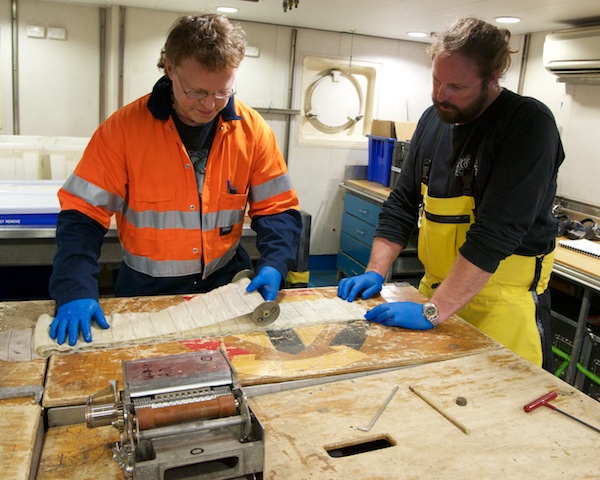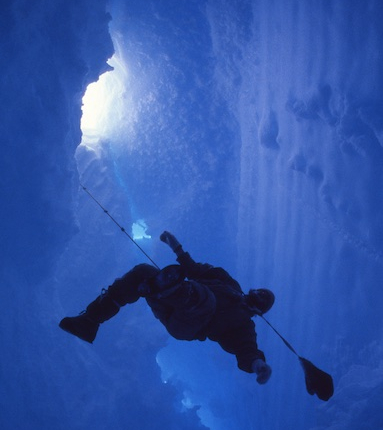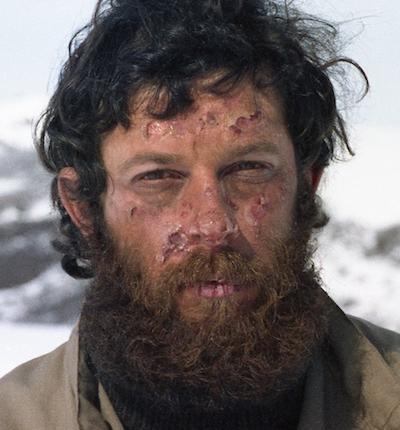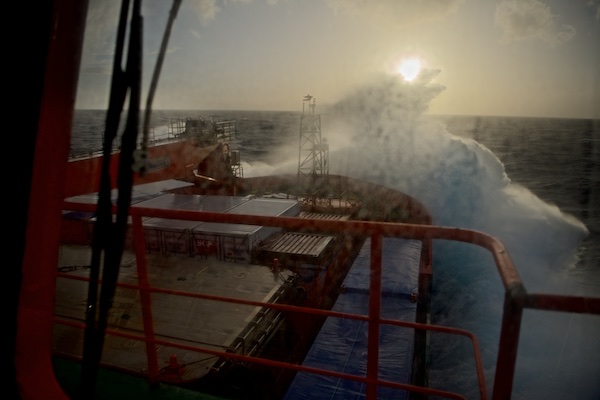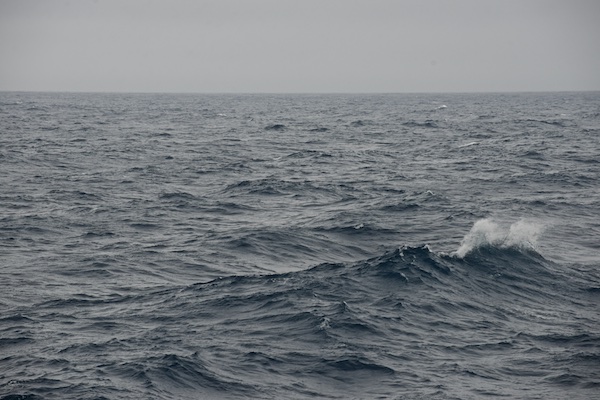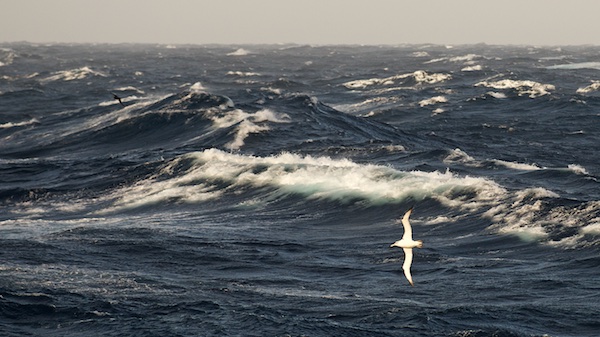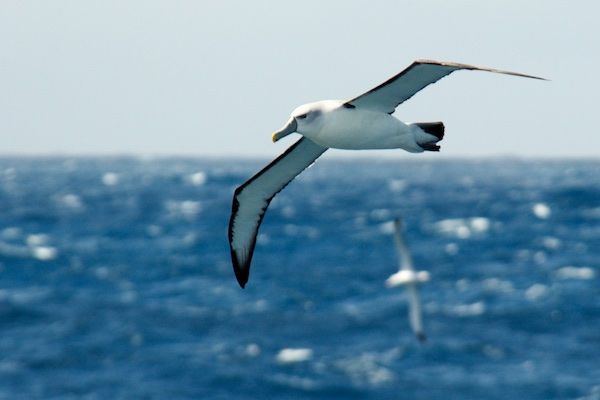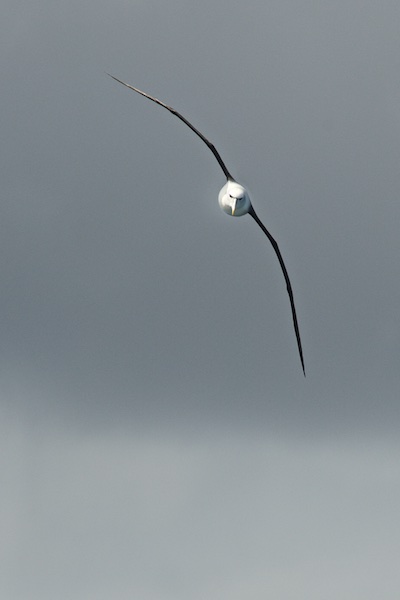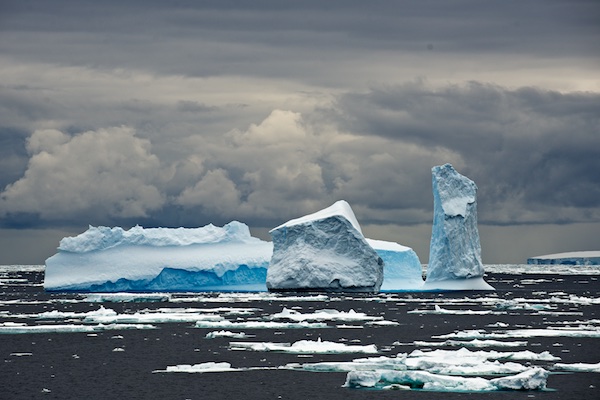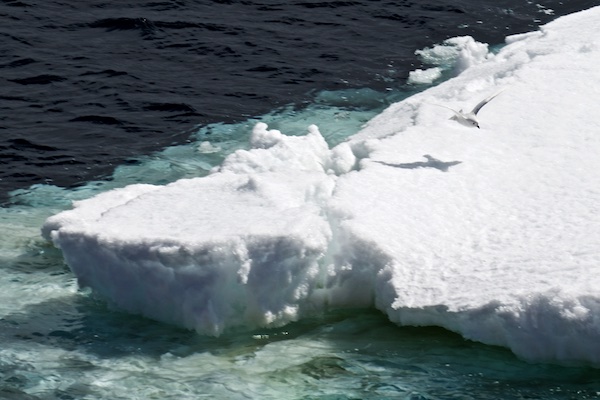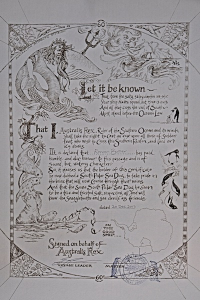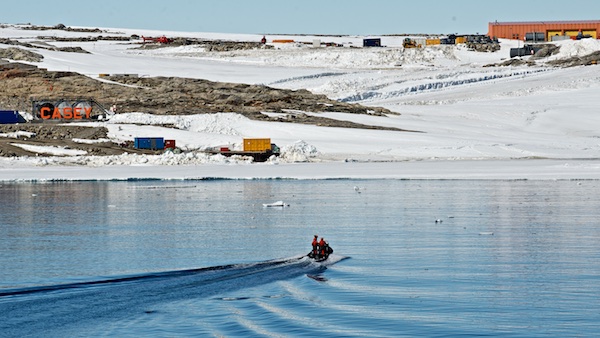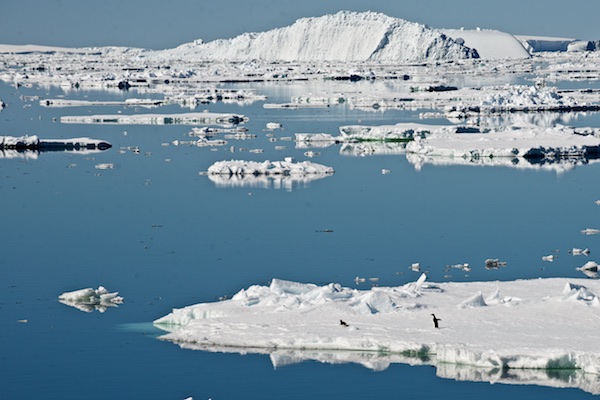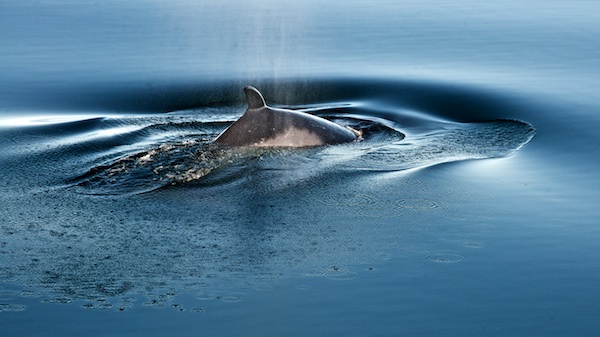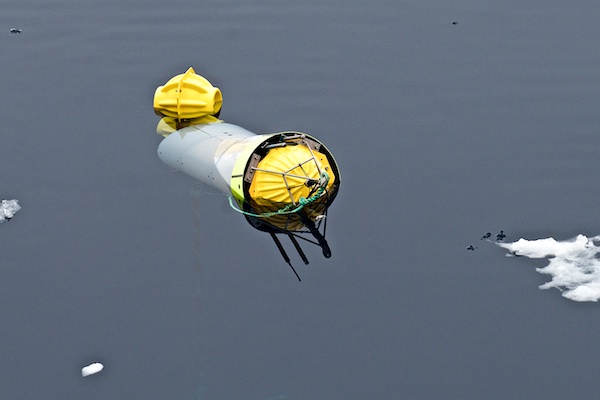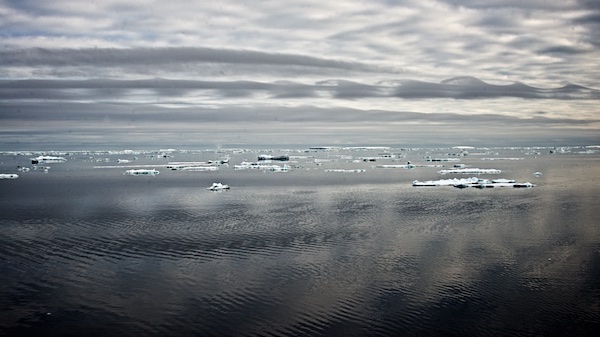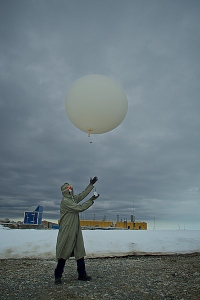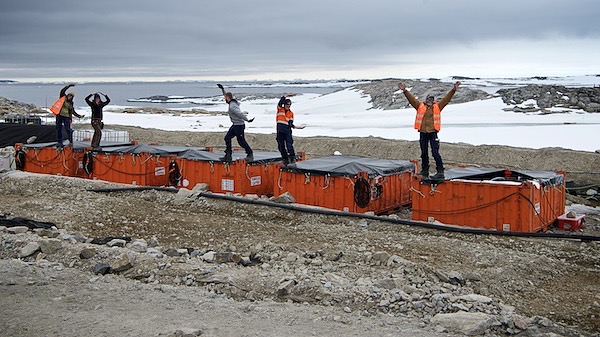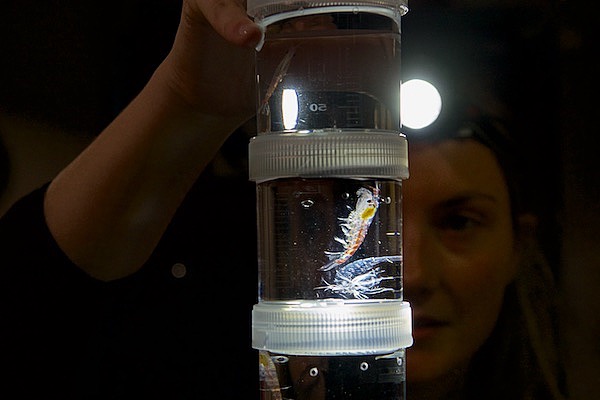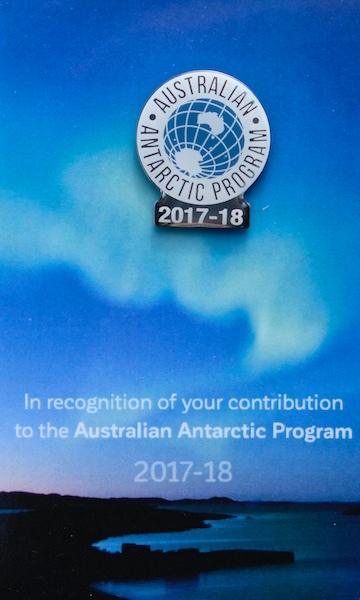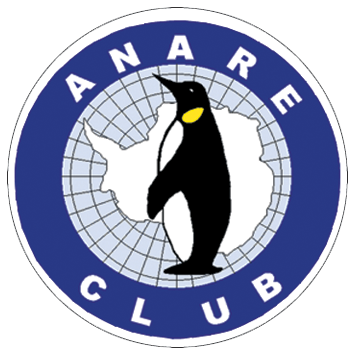Rowan Butler – ANARE Club Representative 2017-18
Voyage 2 Aurora Australis – Casey resupply
Aurora Australis departed Hobart 13 December 2017, at Casey 23-31 December and returned Hobart 10 January 2018
1. Wednesday 5 December 2017 Thoughts on heading South (again)
I have reached out and touched the bottom of the Aurora Australis’ hull, on a visit to see its construction at Carrington Slipways at Newcastle. At its launch in 1989 I photographed it as it slid sideways into the water for the first time but I have never actually set foot on board. Now that it is to be replaced, I finally have the opportunity to sail on it!
The Icebird and the Lady Franklin are two of the ships that I travelled on but my favourite was “the little red ship,†Nella Dan (“always the fastestâ€). I went to and from Mawson for my first winter over 1981 on the Nella, did a number of marine science voyages on her and was on board for the legendary trip in 1985 that dropped off a summering party on Heard Island and then went off to the pack ice for scientific work. We never made it back to Heard Island to pick up the party though, as we got beset in the ice for seven weeks. Nella Dan was involved in more drama that season when on the return from picking up the summer party to Bunger Hills that I was a member of, the ship was directed to bring back returning expeditioners from Davis and Mawson because the Icebird had to return to Hobart after the drive gear to its propeller shaft got damaged. We had 66 passengers with people sleeping on couches and the floor.
The upcoming Voyage 2 Casey resupply should be a little less crowded and soon I’ll be heading off to Hobart to get my clothing kit, be briefed and sail off to Casey, where I spent 1984. At least some of it, as I was fortunate to go on the spring and autumn traverses of two and four months each respectively. We drove straight south and saw a lot of the “great white hell.†However, the old station I lived and worked in is no more and I’m looking forward to seeing the new – but now rather old – station, which was being built when I was there.
Roll on 13 December when I head south again. It’s all rather amazing and still a bit unbelievable as I never thought I’d be going back!
2. Sunday 10 December 2017 Once More on My Adventure
Once more on my adventure is what I’m feeling. These words also happen to be the title of a biography about Frank Hurley who is a hero of mine as he was such a great photographer, and I particularly like his Antarctic work.
The entrance building of the Australian Antarctic Division is named after Hurley but oddly, it lacks a single print from this famous Australian Antarctic photographer. It’s doorway was now the entrance to my next adventure and inside I met with two others who were also about to get their clothing kit. We were given some rather cool warm items and they were a lot more hi tech than my last issue of 1987 vintage.
At the Division, I surprisingly still knew a couple of people working there. My friend Jonothan Davis introduced me to his very helpful supervisor, Jessica, who managed to arrange for me to carry on board more than my 30kg maximum allowance. Perhaps the Aurora is a flying boat?! My estimate of how little my clothing plus my camera gear was going to weigh had been optimistic, as I’m carrying two big DSLRs plus lenses, not a point and shoot! A trip to the wharf three days before sailing this coming Wednesday to hand over the extra weight is required.
I had a bizarre moment yesterday at the home of the friends I’m staying with in Kingston, who I came to know when I worked for Ant. Div. in the 80’s. Henry emerged from his garage/treasure trove with a wooden crate that had RTA (return to Australia) stencilled on it and “Rowan Butler Personal Gear Hold in Ant Div Store, Casey 84/85â€. I had used the box to RTA things from Mawson (hence the red paint) in early 1982 and then to store stuff at the Division in 1984 while I was at Casey. Packaging has moved on from the days of wooden crates, called small, medium or large ANAREs (‘Anaries’), depending in their size.
3. Wednesday 13 December 2017, Heading South
All aboard, Voyage 2 departs at 11am.
An early rise of 5:30am ensured I was on time for the 7am baggage weigh-in at Macquarie #2 wharf and it appeared everyone was within their 30kg limit. After this there was a muster with everyone’s name being called out and ticked off. Well, almost everyone’s, as mine wasn’t. When I pointed this out it seemed to cause some consternation and resulted in me being issued with an orange vest to wear and having a personal escort as I walked with the rest of the group to the ship. At the security fence blocking any family and friends, I needed to go through a special turnstile and hold up my passport in front of a camera. I’m certain if I’d not said anything I could have gone with the others and no-one would have been any the wiser!
On board, a customs check and then more briefings. Yesterday at Antarctic Division we’d had a combination of 10 briefings and training sessions on a variety of subjects that had begun at 8:30am and gone through to 5pm. Presentations included the science programme, fire awareness, cold injuries, clothing, the environment and a practical session on manual handling which debunked all I’d previously been taught about how to lift things.
An announcement near 10:30am declared the gangway was about to be raised and that if you weren’t sailing to Antarctica you needed to get off the ship immediately, “Run – but carefully!â€
We cast off on schedule and there were a few lone Ant. Div. stores staff to watch us pull away. A marked contrast to my first trip south where family and friends were on the dock with streamers being thrown and much cheering and waving. This was a very quiet departure, a bit of a non event and a little disappointing.
From the helideck, some of us watched Hobart and Bruny Island disappear and people made last minute mobile phone calls while still in range of a tower. Out of the quiet Derwent estuary the swell picked up and I saw three blows from whales as Tasmania grew smaller by the minute.
Our contingent is small, only 26 people excluding the ship’s crew, and everybody has a cabin to themselves, with some cabins still being empty. It’s very convenient as one can spread stuff around and it would be tight if I was sharing with the possible three other people the cabin can accommodate.
As some bad weather is coming our way the plan is to go as fast as possible to higher latitudes to avoid the worst of it before turning west. Our course is set, the compass points south, exactly. Says it all.
4. Saturday 16 December 2017, Settled?
People settled in to being on board on Thursday, though some had stomachs which refused to settle and they chose to be horizontal in their bunks. Not that the bunks stayed horizontal, as the seas progressively got choppy, particularly from Thursday night to Friday night that had upright people struggling to remain so at times. I took pills to prevent sea sickness before I boarded and have now weaned myself off them and today risked not taking anything. Fortunately I feel fine and am now free from their side affect of drowsiness. Not having felt ill has let me indulge (overindulge) in the excellent and abundant food. Three hot meals a day with a choice of desserts at dinner and there’s always fruit available.
I watched the recovery of the apparatus which is called the continuous plankton recorder (CPR) that is towed behind the ship. The following information is what I’ve been given regarding this programme:
“As part of the SCAR Southern Ocean Continuous Plankton Recorder (SO-CPR) Survey, zooplankton samples have been intensively collected on most Aurora Australis voyages to the Antarctic continent and back since 1991.
Zooplankton are sensitive to environmental parameters such as temperature, movement of currents and water quality. Due to their sensitivity, short life spans and fast growth rates, plankton populations respond rapidly to environmental change and consequently make excellent biological indicators.
Monitoring of zooplankton populations and communities is therefore an important tool in identifying the effects of both climate change and pollution on the Southern Ocean. Zooplankton are also the principal dietary components of many higher vertebrates, including penguins, seals and sea-birds. Therefore, changes in zooplankton distribution and abundance in the Southern Ocean are expected to have a significant effect on higher trophic levels.
By employing a Continuous Plankton Recorder, surface or near-surface zooplankton can be collected at normal ship speed during a voyage. The unit is usually towed about 100 metres astern of the ship for approximately 450 nautical miles at a time. By splicing consecutive tows together one is able to produce an un-interrupted transect across the ocean, providing information on zooplankton distribution patterns, community structure, and abundance levels.â€
On Friday evening I gave a presentation, screening the film “Douglas Mawson – The Survivor†and then showed photos taken during some of its filming at Mawson Station in the summer of 1981-82. It brought back great memories and I enjoyed explaining how some of the creative scenes were shot. I doubt we’d be allowed to film from inside crevasses these days.
5. Monday 18 December 2017, Grey Day
The photo is indicative of the day. Not much happening and people even seem to be eating less, not because they are ill but from overconsumption. As I said to the galley staff, “Meals are never a disappointment!â€
One high point though was that the iceberg sweep was won, as the first berg of the trip was sighted at 4am this morning by the watch. Only one person had paid for any of the time slots today, that of 6am. Most guesses were for Tuesday or Wednesday. The winner got half the money, the other half going to Camp Quality, the charity for kids and their families living with cancer. As usual though, the winner donated his half to the charity. Not a sign of another berg all day, so I’m still hanging out for my first sight of ice this trip.
The current plan is to head straight for Casey and leave trying to recover the whale recorder mooring until the trip home. We aim to be there on Friday.
Regards,
Rowan
6. Tuesday 19 December 2017, Wind Studies
MARCUS, for Measurements of Aerosols, Radiation and Clouds over the Southern Ocean, is another science project on board. It consists of a mobile suite of many instruments, a few of which are an ozone monitor, a cloud condensation nuclei particle counter, a micropulse lidar, sky radiometers, a total sky imager, and a beam-steering radar wind profiler. It is difficult to keep all the instruments running and clean of sea spray in the harsh and cold environment.
Part of the programme involves sending up radiosonde balloons every six hours and recently I videoed one being done in less than ideal conditions, in a screaming wind and sea spray, the balloon narrowly missing infrastructure as it took off horizontally from the launchers’ hands. The balloons can reach a height of 27km and there is also a radar wind profiler which runs constantly but it is only effective up to around seven kilometres. The collected data are available to the scientific community and will be used to develop and refine climate models, particularly for the Southern Hemisphere as these need improving.
The birds of the Southern Ocean are highly dependent on the powerful winds which circle Antarctica to bear them over vast distances in search of food. Watching birds tailing the ship is something I enjoy and there have been a number of wanderer, sooty and black browed albatrosses skimming over the wind whipped waves as they scour for fish and krill and seemingly just play. Simply gliding, they can easily pass the ship on the strong winds and then circle around behind it again. They may do this for hours and then disappear into the vastness.
6. Tuesday 19 December 2017, Wind Studies
Yesterday evening I sighted my first iceberg for 30 years when I looked out the mess porthole. I had to go and take a photo of course, even though it was 14 km way and I’d seen way better before. Still, it was an exciting sight for me.
Today we met the pack ice and saw a lot more icebergs and reasonably close, and of course are enjoying much calmer waters with the ice dampening the swell. New birdlife too, with the beautiful pure white snow petrels circling the ship, cape pigeons, southern fulmars, giant petrels and the inevitable ones that don’t fly but do swim, penguins. This made for some happy people, those who had never seen one before. Also sighted were some whales and seals. All the numbers were quite small though and you needed to be patient before seeing anything.
Being in much calmer waters, two of us asked permission to go out to the bow. It was worth braving the freezing wind to watch over the bow as the ship dispensed with sea ice floes. Later our doctor took a photo of a rather angry looking seal that was on a floe that the ship nudged aside, disturbing its rest. At least the ship was manoeuvred to avoid hitting the floe head on.
8. Saturday 23 December 2017, Hello Casey, Goodbye Casey
On Thursday we sailed through sunny, calm pack ice to Casey, arriving at 11am. Someone asked me if I felt homesick but I replied that with the old station I spent 1984 at now having gone completely, it looked like a new place altogether which I didn’t recognise.
We lost our Italian and French meteorite hunters who went ashore to fly out the next day in the excellent weather. The four of them were to go on to the French-Italian Concordia Station and then into the field to collect meteorites. One of them gave two excellent presentations during the voyage, firstly on how meteorites get concentrated in places where the ice sheet brings them to the surface in ablation zones against mountains, and secondly about the iron dagger found in King Tutankhamen’s coffin being of meteoric origin.
As fast ice is blocking access to the Casey wharf and because it is too unstable to put the refuelling hose over, the decision was made to sail from Casey and both recover the whale sounds recorder and do the krill fishing programme. In the meantime it is hoped that the bad weather that Casey is expecting will break up the decaying fast ice before our return.
We left Casey on Friday afternoon around 2:30pm and sailed through the pack ice in glorious weather. Little wind, bright sun, brilliant white pack ice and icebergs, blue water, occasional penguins, seals and whales confirmed the well-worn phrase, “the magic of the packâ€. It was my best experience of travelling in pack ice and it was difficult to make the decision to go to bed that night – which of course isn’t at all dark.
A highlight of today was the retrieval of the device for recording whale sounds that was deployed in the ocean a year ago. The ship stopped at the place where the mooring was and tried to determine its position more accurately by communicating with it and using triangulation. Eventually a command was sent to it to release its anchor and it floated to the surface and was retrieved by the crew. It should contain a year’s worth of whale calls and other sounds. A new whale sound recorder was then deployed from the ship’s trawl deck.
Today’s overcast conditions have shown a different beauty of the pack and tonight we travel slowly through it with occasional fog patches creating ghostly icebergs.
9. Monday 25 December 2017, A White(ish) Christmas
Christmas Day and snow fell, not much admittedly, but beautiful flakes blew over the grey sea and ice floes – rather a contrast I imagine to the scene when Jesus was born.
Krill trawling started very early in the morning and continued up until lunch time when all work ceased for the day except for that of essential ship’s crew. Over all the trawls so far, the catches have been largely successful with krill in various life stages having been caught.
Christmas lunch was sumptuous with many choices of meats, desserts, wine, beer and other fare and began for everyone after some brief speeches and the cutting of the very large fruit cake by the Captain
A lazy afternoon with some fun games followed and people grazed on the leftover food, as there was no evening dinner. The ship headed back towards Casey, expecting to arrive about 7am on Boxing Day.
Regards,
Rowan
10. Tuesday 26 December 2017, New and Old
The Aurora Australis duly arrived at Casey again at 7am and as per instructions I was ready with my kit to go ashore at 8:30am. It was then a case of ‘hurry up and wait’ and the boat took two of us ashore at 10am, where it was nice to be on terra firma once again.
Before leaving Australia I had been advised that I could go ashore if it could be arranged but would be sleeping on the ship. However, a deal had been struck with Casey that I could stay ashore until Friday if I would work in the kitchen and mess as slushy for two days. A fair enough deal as far as I was concerned.
I was given a room in the new ‘East Wing’ of the Red Shed accommodation building. It’s a new section tacked on to the end of the building and contains over 40 rooms to accommodate people passing through Casey, which is now a hub for flying to other stations, and not only Australian ones. Although the rooms are smaller than for a wintering expeditioner, they are generous compared with the six foot square donga with a curtain across the doorway that I had as an expeditioner.
After an induction to Casey explaining where I’m allowed to roam, the rules, customs and expectations, I met with the Station Leader and Operations Manager and we discussed my Service Level Agreement. This had been written by Antarctic Division before the voyage after asking me what I wanted to achieve during my visit. I had written a wish list of many things, hoping that I might be able to do some of them but realised that during resupply everyone has a lot of jobs to do and showing tourists around isn’t one of them. However, I was now told it seemed possible that one day a trip accompanying field workers in a helicopter might be possible. This was unexpected, positive and exciting!
I went for a walk to Reeve Hill, named after Geoff Reeve, who died in a blizzard near Casey in 1979, and took in the calm and sunny scene of the base with the ship anchored in Newcomb Bay. On my return for dinner, the Operations Manager informed me that a trip to accompany a technician to replace a Bureau of Meteorology automatic weather station on Haupt Nunataks the next morning, plus another to Wilkes Station in the afternoon, had been slated, both by helicopter – weather permitting. This prospect certainly surpassed that of being slushy!
In the evening I walked down to where the old Casey Station had been and there was little left to see. Small stumps of scaffold pipes bleeding rusty stains over the surrounding rock and anchor points with D shackles cut through with an oxyacetylene torch were the only traces. It had taken moments to remove pipes and fixtures that years ago had been labouriously embedded in the rock to hold up a place where people lived and worked. It was all rather sad. It seems that Wilkes Station has had a better end, even though it is virtually buried in snow it still exists, but there is nothing left of the the station I called home for a year of my life.
Regards,
Rowan
11. Thursday 28 December 2017, Slushy
Yesterday my great hopes of exciting trips in a helicopter came to a weather-defeated end. The morning trip to the automatic weather station never got off the ground because of high wind and the afternoon trip to Wilkes was cancelled at the point of sitting in the chopper with one of the cooks with our seat belts fastened, waiting to take off. Thwarted by light snow and the poorest weather of the day.
In the evening after dinner I ran the ANARE Club “shop†in the bar area, which isn’t open during resupply. Followed this up with a presentation in The Odeon (the great little cinema), screening “Surviving Extremesâ€, a documentary comparing the problems of living and working in space with Antarctica, and which uses some of the “Douglas Mawson the Survivor†footage. I then gave a short talk and it was all well received.
Today I worked as slushy in the kitchen and mess, washing up a mountain of pots and utensils, cleaning tables and mopping floors. I shared the work with one of the doctors and though busy it was a good time chatting with the cooks and others. Occasionally people would lend a hand for a while too.
I got a few hours break though as at 2pm I was taken over to Wilkes Station in a Hagglunds vehicle. Beautiful weather and we stopped outside the “Wilkes Hilton†(no valet parking though), the old transmitter hut that is now a field hut, which looks even more comfortable than it did in 1984. We walked around the station, which is buried more than ever, and I’m told that none of the buildings can be entered now because they are full of snow and ice. Things around Wilkes that would have been classified as rubbish some years back are now seen as heritage items.
In the evening people asked me about the old Casey station and I found out details of some of the current science programs. All in all a great day and tomorrow there is the prospect of another attempt to get to the Haupt Nunataks and the weather station, plus my time ashore has been extended to Sunday.
Regards,
Rowan
12. Saturday 30 December 2017 The Automatic Weather Station
Friday morning was overcast and breezy but visibility was good and I held onto hope that we would yet fly to Haupt Nunataks in the Vanderford Glacier to the automatic weather station (AWS). Finally I received word that we were to go and at 11:10am we rose above Casey to a sweeping view of the station, the ship and the watercraft preparing to refuel the base, the ice of Law Dome and the iceberg littered ocean.
Fifteen minutes later we landed on the largest of the nunataks and then the four of us unloaded the gear. There was the pilot, a field training officer, the technician from the Bureau of Meteorology and myself.
The AWS was new but wasn’t working properly so we dismantled the mast and the Met tech replaced the electronics and wind sensors. The weather was good with little wind and it wasn’t particularly cold, which made handling the gear without gloves an easy task compared with what it can be like. It looked to me as if the equipment had been designed for warmer climes though and not made for being worked on in freezing conditions. The three AWSs I had deployed on the four month long 1984 Spring traverse to the south of Casey were clunky affairs but made to be erected while wearing mitts, which was good because we had to work in the minus fifties. The lowest temperature we had on that trip was -64C.
Before we had finished putting up the mast again there was a call from Casey to say the weather there was closing in, so we had to race to put up the mast, tighten the stays, wire up the turnbuckles to prevent them vibrating loose, reload the helicopter and take off. Following the coast line back to Casey the weather looked bad and the pilot made the decision to fly back to the Browning Peninsula field hut.
After landing we collected some snow and put it on the stove to melt and boil for a cuppa, then went for a wander about, staying close to the hut. On a low ridge I had a view of the ice cliffs and rugged hills of the coastline. For the first time since leaving Hobart there was silence, no humming of the ship or the Casey generators, just quiet – the peace was wonderful.
Alas, before the snow melted in the pot, there was another call from Casey to say the weather had cleared there, so it was back in the chopper for a quick flight back to the station. Pity, a couple of us were thinking that being stranded at Browning for a night would have been quite nice!
Well, that was yesterday and today it was a return to reality as I was slushy again – but a fair tradeoff as far as I’m concerned. This morning kitchen waste had to be driven to the garbage incinerator and the recycling depot. As I hadn’t been inducted into how to drive a Toyota ute, someone else had to drive. Later as I was attempting to operate a coffee maker, a kind of machine I am not familiar with, I pondered on how I was allowed to use this scalding, steam spitting machine with only a few instructions on the wall, but not allowed to drive a vehicle that I’ve been licensed to for around half a century!
13. Sunday 31 December 2017 New Year’s Eve
A day of many interesting things for me, beginning with accepting the offer to launch a meteorological balloon. Under close supervision I released the 10:15am flight and then went into the Met office to watch the incoming data converted to graphs on a computer monitor. All over the world, twice a day at around the same time, balloons are released and a snapshot of the world’s weather is taken and the results sent to three centres at Moscow, Washington and Melbourne for analysis and distribution. It’s one of the few things where the countries of the world co-operate.
Later I visited the Science building and was told about work being done investigating levels of metals in the seawater leached from rubbish and other items left at Casey in the past and Wilkes and how, if at all, this affects tiny animals living in the water and sediments. The aim is to establish benchmarks, using these organisms, for what levels of metals are acceptable and use these for checking pollution levels at other Antarctic stations to determine whether cleanups should be done. For more details on this work see www.darrenkoppel.com
I then followed some of the science team down to the sea ice in Brown Bay. As I hadn’t done any survival training I had to stay on shore while the team went out on the ice. A hole was drilled through the two metre thick ice so as to deploy a device for absorbing metals that may be in solution in the water. Also a core was taken to retrieve algae and associated micro organisms from the bottom of the ice.
Despite it being New Year’s Eve there were no festivities as we were still in the period of resupply and there was no alcohol allowed – much to the chagrin of some! It felt like any other evening but a celebration of New Year will happen after the ship leaves and likewise on board the Aurora, where we will have a party to mark New Year and also give out the Christmas presents that still reside under the tree. At midnight some of us went outside to take in the view across Newcomb Bay, the low sunlight creating a spectacular scene.
14. Monday-Friday 1-5 January 2018 Mission Accomplished
Early to bed and early to rise on the same morning just makes one tired for the rest of the day! This New Year’s Day was my last day on land for a while and I had a lot of things to pack in. Washing and drying my linen, returning my survival pack to the field store, interviewing one of the cooks for the Club oral history programme and thanking people who had made my time at Casey so interesting and enjoyable, especially the Station Leader and Operations Manager.
I also managed to visit the remediation site where work is being done to clean up a fuel spill. The dirt and gravel is in long piles and the bacteria in the soil is gradually breaking down the fuel. Once clean, the gravel can be used in other areas around the station instead of having to quarry more. Experiments are also being run to test other methods of cleaning up spilt fuel to see which one would be the most efficient in case of future spills.
On the way to the wharf to return to the ship, a lone Adelie penguin rested on a snow bank at the roadside, completely unphased, and when we pulled up in the vehicle to look at it, it stood, stared in through the window at us, flapped its wings and answered us in squawks when we spoke to it, very comical.
Another smooth trip back to the ship in the late afternoon in the inflatable rubber boat with the ever competent watercraft operators saw us just in time for dinner, which was followed by a muster to make sure everyone was accounted for.
During Tuesday and Wednesday cargo continued to be unloaded and by late Wednesday everything had been delivered, Casey’s resupply was finished, mission accomplished. Now things to be returned to Australia (RTA) had to be brought aboard. Ship-bound, I sorted through pictures and wrote up blogs, which take me a long time.
On Thursday the work was to bring aboard the RTA stuff and although it looked like this would go through to Friday morning, by putting in a bit of extra time at the end of the day, it was all finished on Thursday night. The ship’s crew and watercraft operators could then take a well earned rest before we set sail at 11am on Friday morning.
Since New Year’s Day the weather had been overcast but on Thursday afternoon it cleared, providing some beautiful scenes of penguins swimming around the ship and of reflections in Newcomb Bay.
On Friday morning the Aurora’s horn sounded and ashore at Casey flares were set off to mark our departure. We sailed out of the bay and off through the pack ice and as the station and continent grew smaller I thought that I’d probably never see them again, though that’s what I imagined the last time I sailed away from Antarctica in the late 80’s.
The pack provided more scenes of penguins, seals and whales, though under a clouded sky. Someone called me at one point to say there were whales. There certainly were, with whales continually breaching – a great photo opportunity. When examining the pictures later what I thought at the time was the ominous fin of an orca that was trying to get between a calf and its mother, turned out to be half of a minke whale fluke and the young whales were simply in a playful mood.
Regards,
Rowan
15. Saturday 6 January 2018 Party Time With Ice
Last night and this morning the krill seekers trawled and were successful in getting a good catch, which will restock the Kingston aquarium.
The day produced some good opportunities for photos of birds and icebergs. Hour by hour though the pack ice thinned until there was none, just icebergs and even they became few and far between. I did manage to bid a fond farewell to the ice by getting a photo of the last iceberg sighted, at 1:30am on Sunday morning. The ship now has a gentle roll in the increasing swell.
The highlight of the day was dinner of pizza, wine, beer and champagne for our festive occasion in lieu of New Year. After toasting the crew in recognition of their hard work, everyone went to the lounge and the presents from under the Christmas tree were distributed. Cabin numbers were called out and the occupant chose whatever package they fancied.
My last Christmas at sea was unscheduled and aboard Nella Dan in 1985. Unscheduled because we were meant to be home well before Christmas but got beset in the pack ice for seven weeks and had to be rescued by the Japanese icebreaker Shirase. On that occasion Santa came during the night and left me chocolate, liquorice allsorts, a paperback and two pairs of ANARE issue socks!
Regards,
Rowan
16. Sunday-Thursday 7-11 January 2018 RTA – Return to Australia
Our north easterly journey home continued over the days, with most people having little to do, though some continued on with scientific programmes or had reports to write. Every evening there has been an interesting, illustrated presentation and we have been informed about the refuelling process at the American McMurdo Station, atmospheric studies, the breakup and study of the Larsen A, B and C ice shelves and how the British Antarctic Survey runs its field programmes, contrasted with how Australia does things, and a talk on krill.
We suffered an increasing swell with up to four metre high waves and coming broadside onto the ship, which started to make me feel off one evening, for the first time in the whole trip. Fortunately things eased the following day. The rolling produces some interesting sounds from within the ship, with the water ballast flowing from one side to the other displacing air in the system, which makes erie and even weird screaming noises.
Sailing to lower latitudes has brought about nights that are actually dark and the air temperature has been getting uncomfortably warm, requiring lighter clothing. I have been keeping busy and have been able to sell Club items and recorded an interesting oral history with an expeditioner who has seen the changes in expeditions over many years.
As the Aurora Australis is to be replaced in a few years, people have taken the opportunity to buy memorabilia from the ship’s shop. This is the new ship for me but it is actually now the old ship, so I too bought a few items including postcards which I had the ship’s stamp put on, along with the Captain’s signature.
As we approached Tasmania on our last day today, we nervously awaited the cabin inspection, people hanging around in their doorways after industriously vacuuming and cleaning! I believe no-one was issued with a defect notice though. Having the cabins clean and ready for the next voyage saves the stewards an enormous amount of work.
Coming up the Derwent it was nice to see green hills again and Mt Wellington watching over Hobart. There was a final meeting where the Voyage Leader thanked individuals for their efforts in making the trip a success. Then we took our bags upstairs ready to be taken ashore, watched as we docked, then went inside again to be processed by customs. This was a new experience for me as I’d always been able to go ashore without any officialdom.
A last curiosity was to file off the ship, have our names checked off at the bottom of the gangway (to ensure no-one stowed away?) and then go by chartered coach a whole 380metres to a venue in the wharf area. There a small ceremony was held and each expeditioner was presented with a badge of the logo of the Australian Antarctic Program. A nice touch and something new for me.
My overall impressions of modern operations are that some things have improved and are done more efficiently and in a safer manner than in the 80s. I met an expeditioner at Casey who commented that what may eventually make him decide to stop going south are the ever more restrictive rules being put in place to try and ensure people’s safety. Although things may have been done in a less safe manner in the past, I am happy to have experienced working in Antarctica when I did.
Going to Antarctica again has been a marvellous experience, and my thanks go to Antarctic Division and all the helpful people there, the ANARE Club and those I travelled with who have made this a great trip!
Regards,
Rowan
